Classic Antarctica 11 days / 10 nights
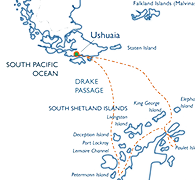
-
Day 1 Depart from Ushuaia
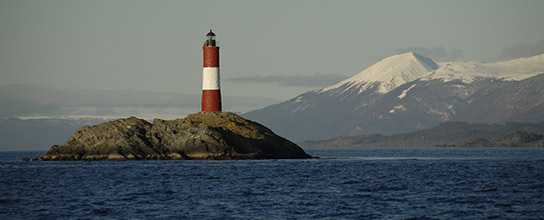
Embark the USHUAIA in the afternoon and meet your expedition and lecture staff. After you have settled into your cabins we sail along the famous Beagle Channel and the scenic Mackinlay Pass.
-
Day 2 to 3 Crossing the Drake Passage

Named after the renowned explorer, Sir Francis Drake, who sailed these waters in 1578, the Drake Passage also marks the Antarctic Convergence, a biological barrier where cold polar water sinks beneath the warmer northern waters. This creates a great upwelling of nutrients, which sustains the biodiversity of this region. The Drake Passage also marks the northern limit of many Antarctic seabirds.
As we sail across the passage, Antarpply Expeditions' lecturers will be out with you on deck to help in the identification of an amazing variety of seabirds, including many albatrosses, which follow in our wake. The USHUAIA's open bridge policy allows you to join our officers on the bridge and learn about navigation, watch for whales, and enjoy the view. A full program of lectures will be offered as well.
The first sightings of icebergs and snow-capped mountains indicate that we have reached the South Shetland Islands, a group of twenty islands and islets first sighted in February 1819 by Capt. William Smith of the brig Williams. With favorable conditions in the Drake Passage our lecturers and naturalists will accompany you ashore as you experience your first encounter with the penguins and seals on Day 3.
-
Day 4 to 8 Exploring the Antarctic Peninsula and the South Shetland Islands
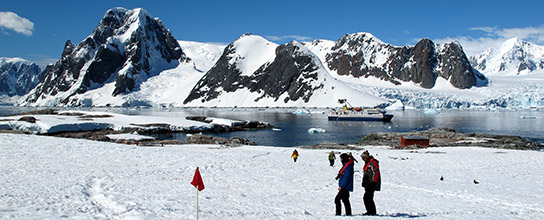
The South Shetland Islands are a haven for wildlife. Vast penguin rookeries, beaches ruled by Antarctic fur seals and Southern elephant seals make every day spent in this amazing island group unforgettable. Sailing through the narrow passage into the flooded caldera of Deception Island is truly amazing.
King George Island, the largest of the South Shetland Islands, features colonies of nesting Adélie and Chinstrap Penguins, Kelp Gulls, Blue-eyed Cormorants, Antarctic Terns and Southern Giant Petrels and is home to scientific bases of many different countries. Macaroni, Chinstrap and Gentoo Penguins as well as elephant seals await you at Livingston Island.
The Antarctic Peninsula’s remarkable history will provide you with a type of excitement often only associated with the early explorers. You will have plenty of time to explore its amazing scenery, a pristine wilderness of snow, ice, mountains and waterways, and an incredible wide variety of wildlife. Apart from penguins and seabirds you are very likely to see Weddell, crabeater and leopard seals as well as Minke, killer (orca) and humpback whales at close range.
We hope to navigate some of the most beautiful waterways (depending on the ice conditions): the Gerlache Strait, the Neumayer Channel, and the Lemaire Channel, the latter are narrow passages between towering rock faces and spectacular glaciers.
We plan to make at least two landings per day and possible landing sites may include Paradise Bay which is perhaps the most aptly named place in the world and we attempt a landing on the continent proper. After negotiating the iceberg-strewn waters of the Antarctic Sound, we hope to visit the bustling Adélie Penguin (over 100,000 pairs breed here) and Blue-eyed Cormorant colonies on Paulet Island. The Nordenskjöld expedition built a stone survival hut here in 1903. Today its ruins have been taken over by nesting penguins.
Further exploration may take you to Melchior Island, Cuverville Island, Portal Point, Neko Harbour, Pléneau Island and if ice conditions permit, to Petermann Island for a visit to the southernmost colony of Gentoo Penguins.
-
Day 9 to 10 At Sea crossing the Drake Passage, northbound
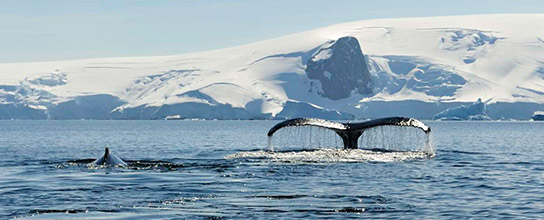
We leave Antarctica and head north across the Drake Passage. Join our lecturers and naturalists on deck as we search for seabirds and whales and enjoy some final lectures. Take the chance to relax and reflect on the fascinating adventures of the past days on the way back to Ushuaia.
-
Day 11 Arrival at Ushuaia

We arrive at the port of Ushuaia in the early morning and disembark the USHUAIA after breakfast.
Vessels
-
The Ushuaia
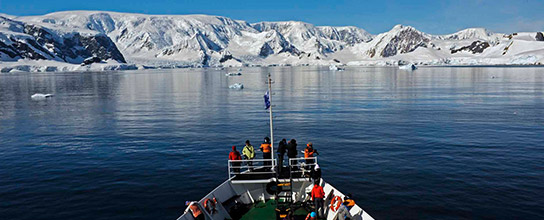
The USHUAIA has been refurbished to accommodate a maximum of 88 passengers in 46 comfortable cabins and suites.
Originally built for the United States agency NOAA (National Oceanic & Atmospheric Administration), the ice-strengthened polar vessel USHUAIA is very well appointed and provides ample deck space and an open bridge policy. The full complement of inflatable landing craft ensures superb landings and wildlife viewing opportunities on the otherwise inaccessible coastline.
All cabins include ample storage space. Public areas feature a large dining room (one sitting), an open-plan observation lounge / lecture room with modern multimedia equipment, bar and a well-stocked library. There is also a changing room and a small infirmary. Our expert captain, officers and crew are highly experienced in Antarctic navigation and have a great love of nature. We provide a specialist team of international expedition leaders and lecturers, all extremely knowledgeable, enthusiastic, helpful and dedicated to the protection of the environment. Our chefs prepare excellent cuisine including many local specialties and the bar is well-stocked with carefully selected wines and spirits.
Facilities
Four DecksDining Room (One Open Seating)Observation Lounge/Lecture Room, Bar & LibraryPanorama DeckGift ShopInfirmaryZodiacs

